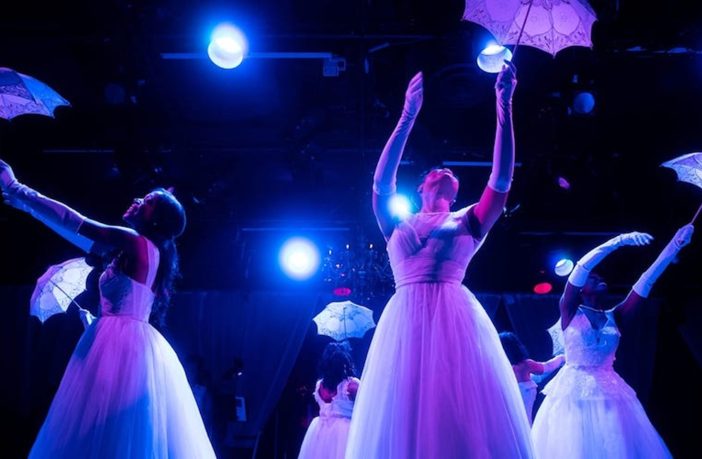An interaction with a former co-worker inspired Colette Robert to write The Cotillion, currently playing off-Broadway at the New Georges in New York City. “He mentioned how big debutante balls were where he was from in St. Louis,” she shares. “As he was talking, I imagined a grand, glittery room with Black women and girls of all shapes and shades wearing white ball gowns, twirling and dancing, and I thought to myself, that’s a play!”
Also known as The Harriet Holland Social Club Presents the 84th Annual Star-Burst Cotillion in the Grand Ballroom of the Renaissance Hotel, the music-infused drama follows 6 young women who have been primped and prepped for a year under the watchful eye of Madame President, who will allow for nothing less than perfection on their coming out day. But we quickly learn that this glittery world masks a host of personal demons and trauma. The play becomes an interrogation of social hierarchy, racism and sexuality issues.
Here Robert shares how The Cotillion came into being and the meaning behind its commentary.
EBONY: What type of research did you do on Black social clubs and fraternal organizations?
Colette Robert: At first, I thought the play would take place in New Orleans, so I read a lot about all of the balls hosted by various Mardi Gras krewes. I read about the history of debutante balls in America, the history of African Americans and dance and the Black upper class. And then I interviewed a lot of friends and acquaintances about their personal debutante experiences. I was in the research stage for about a year and a half before I actually started writing.
Did you do any research into the Divine Nine and other Black social and fraternal organizations for the play?
I am not in a sorority or part of a social group like Jack and Jill of America, but I am adjacent to those worlds. I went to a mostly white private high school in Los Angeles, and several of my friends debuted with The Links. I also have a lot of family members and friends who were in sororities, Alpha Kappa Alpha Sorority and Delta Sigma Theta Sorority, specifically. I drew on a lot of personal experiences from my childhood and adolescence, and there’s a part of my experiences in each of the characters.
Why do we need to examine themes of sexism and racism behind debutante balls?
Going into the writing process, my big question was about how are we presenting and valuing Black girls and women in America and what is that history. The Cotillion takes place during a Black debutante ball, but the issues I wanted to explore—classism, colorism, respectability politics—are systemic. In an office or a subway car and on our favorite TV shows, we make assumptions and judgments just based on what we see. My hope is that The Cotillion challenges some of those assumptions.
How did a New York City grant, the New Georges and The Movement Theatre Company help bring this show to life?
I came up with the idea for The Cotillion almost 9 years ago and New Georges and The Movement Theatre Company have been supportive of the play from the very beginning. In 2018, they reached out and said they wanted to apply for a big arts grant in New York City. If they got the grant, they could produce The Cotillion, and they were true to their word! Them saying yes to this show truly brought it from a Word doc on my computer to a living, breathing, fully realized production.
What other themes would you like to explore in your writing as a commentary on Black society in America?
There’s a lot to comment on! My second play, which I mostly wrote during the stay-at-home part of the pandemic, is very loosely inspired by Black Arctic explorer Matthew Henson. It explores Black bodies and white landscapes and our relationship to nature.
The Cotillion is playing at New Georges in New York City through May 27, 2023.



